mobile Ansicht, to the English Version tap the flag
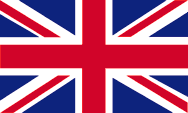

- Autonome Region Spaniens
- auch: Neukastilien
- 1085–1833 Königreich Toledo
- Eigenbezeichnung:
Spanisch: Castilla-La Mancha
• Flagge
• historische und andere Flaggen
• Bedeutung/Ursprung der Flagge
• Wappen
• historische Wappen
• Bedeutung/Ursprung des Wappens
• Landkarte der autonomen Regionen Spaniens
• Zahlen und Fakten
• Geschichte
• Ursprung des Landesnamens

seit 1980,
Flagge von Kastilien-La Mancha,
Seitenverhältnis = 1:2,
Quelle, nach: Flags of the World, World Statesmen





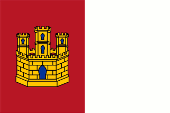
seit 1980,
offizielle Flagge von Kastilien-La Mancha,
Seitenverhältnis = 2:3,
Quelle, nach: Flags of the World, Wikipedia (ES)






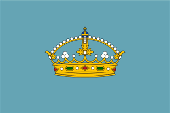
1085–1833,
Flagge des Königreichs Toledo,
Seitenverhältnis = 2:3,
Quelle, nach: Wikipedia (ES)




Die Flagge von Kastilien-La Mancha wurde am 25.01.1980 offiziell eingeführt und am 17.08.1982 per Gesetz bestätigt, als die Autonome Gemeinschaft Kastilien-La Mancha gegründet wurde. Jedoch war die Flagge schon seit 1978 inoffiziell in Verwendung. Sie zeigt das Bild des Wappens (laut Gesetz zeigt das Wappen das Bild der Flagge!), ist vertikal geteilt und zeigt zwei Felder in Karmesinrot und Weiß, sowie in der Mitte des roten Feldes eine goldene Burg mit drei Türmen. Das rote Feld der Flagge mit der Burg entspricht der traditionellen Heraldik von Kastilien, jedoch nicht von Neukastilien, dem ehemaligen Kastilischen Königreich Toledo, auf dessen Gebiet Kastilien-La Mancha heute liegt. Das Kastilische Königreich Toledo hatte als Wappen einen hellblauen Schild mit einer Krone darin. Das weiße Feld der Flagge soll an die Mäntel der Ritter und Kreuzfahrer erinnern, die die Region des heutigen Kastilien-La-Mancha im 12. und 13. Jahrhundert vom Joch der Araber befreiten. Unter der der Regierung des Generals Franco (1936–1975) waren alle regionalen Flaggen verboten. Nach Francos Tod (1975) wurden die regionalen Flaggen wieder eingeführt, bzw. neue geschaffen. Kastilien-La Mancha war bis dato nicht existent, hatte also vorher keine eigene Flagge, so dass im Jahre 1978 die neue Flagge eingeführt wurde, wenn auch zunächst inoffiziell, da Kastilien-La Mancha bis 1982 noch keinen Autonomiestatus hatte. Ämter und Behörden halten sich an die Vorgaben des Artikels 39.1981 des spanischen Gesetzes 6/2, das vorschreibt, dass an mehreren Masten, von denen einer die spanische Flagge zeigt, keine Flagge größer sein darf als die spanische Flagge selbst. Insofern hissen Ämter und Behörden die Flagge im Format 2:3. Privatpersonen halten sich an das Organgesetz Nr. 9/1982 vom 10.10.1982 über das Autonomiestatut von Kastilien-La Mancha, das ein Seitenverhältnis von 1:2 vorschreibt. Die Flagge wird in der Praxis in vielen Formaten reproduziert, und auch das Karmesinrot zeigt viele Varianten die bis zu Purpur gehen können, denn der Farbton des Rot ist nicht festgelegt.
Quelle: Wikipedia (ES),
Flags of the World,
World Statesmen,
Volker Preuß


seit 1983,
Wappen von Kastilien-La Mancha,
Quelle, nach: HansenBCN,
CC BY-SA 3.0, via Wikimedia Commons

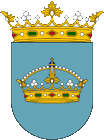
1085–1833,
Wappen des Königreichs Toledo,
Quelle, nach: Wikipedia (ES)

Das Wappen von Kastilien-La Mancha wurde am 30.06.1983 und zwar nachdem die Autonome Gemeinschaft Kastilien-La Mancha im Jahre 1982 gegründet worden war. Kurioserweise stand dafür die Flagge Modell. Der Wappenschild ist gespalten und zeigt in seiner heraldisch rechten Hälfte die Heraldik Kastiliens: eine goldene Burg mit drei Türmen auf (karmesin)rotem Hintergrund. Die heraldisch linke Hälfte ist einfarbig weiß und soll an die Mäntel der Ritter und Kreuzfahrer erinnern, die die Region des heutigen Kastilien-La-Mancha im 12. und 13. Jahrhundert vom Joch der Araber befreiten. Oberhalb des Wappenschildes erscheint eine Königskrone. Das rote Feld mit der Burg entspricht der traditionellen Heraldik von Kastilien, jedoch nicht von Neukastilien, dem ehemaligen Kastilischen Königreich Toledo, auf dessen Gebiet Kastilien-La Mancha heute liegt. Das Kastilische Königreich Toledo hatte als Wappen einen hellblauen Schild mit einer Krone darin.
Quelle: Wikipedia (ES), Volker Preuß

Die autonomen Regionen Spaniens:
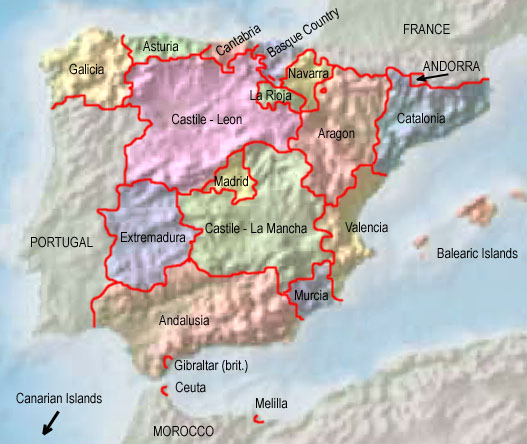
Quelle/Source: Freeware, University of Texas Libraries, modyfied by: Volker Preuß

Fläche: 79.463 km²
Einwohner: 2.069.423 (2022), meist Neu-Kastilier
Bevölkerungsdichte: 26 Ew./km²
Hauptstadt: Toledo, 85.085 Ew. (2022)
Amtssprache: Spanisch (Kastilisch)
Währung: spanische (Euro-)Währung
Zeitzone: MEZ
Quelle: Wikipedia (DE)

Die Gebiete Kastiliens nördlich des Zentralspanischen Iberischen Scheidegebirges (es erstreckt sich von Südwest nach Nordost) werden Altkastilien genannt und wurden bis etwa 1050 von den Arabern befreit. Die Gebiete südlich davon heißen Neukastilien und wurden bis etwa 1220 von den Arabern befreit. In Neukastilien wurde bereits 1085 das Kastilische Königreich Toledo errichtet, das bis 1833 bestand. Danach wurden ganz Kastilien und das Kastilische Königreich Toledo in Provinzen unterteilt, Neukastilien in die Provinzen Madrid, Guadalajara, Cuenca, Albacete, Ciudad Real und Toledo, aus denen am 16.08.1982 die Autonome Gemeinschaft Kastilien-La Mancha hervorging. Madrid wurde am 01.03.1983 eine eigene Autonome Gemeinschaft.
Quelle: Wikipedia (DE),
Volker Preuß

Der Name "Kastilien-La Mancha" kombiniert die Begriffe "Kastilien" und "La Mancha". Der geographische Begriff "Kastilien" meint heute ein riesiges Territorium in Zentralspanien. Diese riesige Fläche wurde erst im Zusammenhang mit der Befreiung der Iberischen Halbinsel von den Moslems, der sogenannten Reconquista, und der damit bedingten Ausdehnung des Territoriums des ursprünglichen Kastilien definiert. Die Gebiete nördlich des Zentralspanischen Iberischen Scheidegebirges (es erstreckt sich von Südwest nach Nordost) werden Altkastilien genannt und wurden bis etwa 1050 von den Arabern befreit. Die Gebiete südlich davon heißen Neukastilien und wurden bis etwa 1220 von den Arabern befreit. Der geographische Begriff "La Mancha" bezieht sich auf eine Hochebene im südlichen Neukastilien, ein Steppenland mit rauhem Klima, sehr langen, heißen Sommern und Wassermangel. Der Begriff "La Mancha" hat arabische Wurzeln, die Araber hatten 500 Jahre lang Einfluss in dieser Region, "Al Manschara" heißt "Das dürre Land".
Quelle: Volker Preuß, Handbuch der geographischen Namen


![]()













